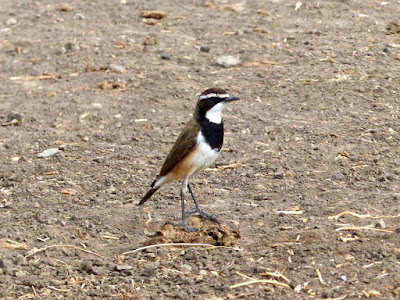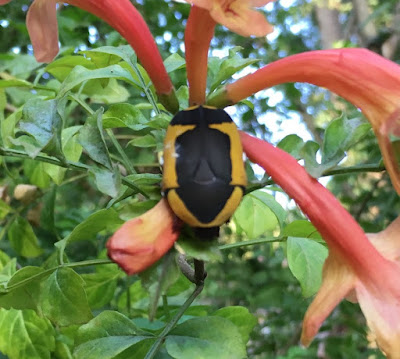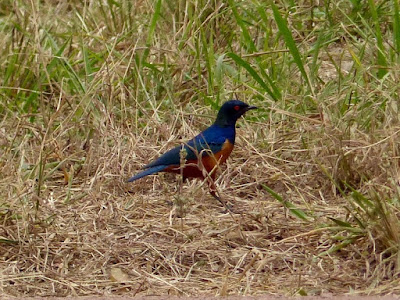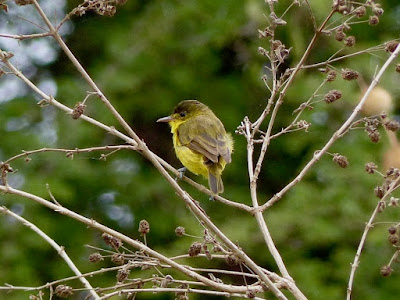 |
| Lake Natron |
Our friends Martin and Kaz Dunstan from Warrnambool are in Tanzania for a month working at the Bandari Project (
www.thebandariproject.com) in Mto wa Mbu, 2 hours west of Arusha. They had the idea of a 4-day safari to Lake Natron near the Kenya border and we went with them in the capable hands of our friend Stanley Mbogo of Zorilla Safaris (
www.zorillasafaris.com).
Lake Natron is about 50 km north-south and 15 km east-west. It is very shallow (mostly less than 3 m) and is fed mainly from rivers flowing in from Kenya. The high evaporation rates and the underlying rock types mean that the water is highly caustic and alkaline. Perfect for flamingos and both African species are there in abundance as seen in many a wildlife documentary. The fresh and brackish water around the edges of the lake teem with many species of waterbirds. We saw large flocks of migratory Little Stints and many other waders.
 |
| Kori Bustard |
 |
| Eastern Chanting-Goshawk |
Stanley picked up Jenny and me in Arusha at 0600 then Martin and Kaz in Mto wa Mbu and we were off the tarmac by 0900 and onto 5-6 hours of gravel for the drive north to our camp. The road runs along the western rim of the Rift Valley with the landscape growing progressively drier and more rugged as we headed north. A highlight along the way was a pair of male giraffe fighting. Mostly they walked together, keeping close eye contact, but periodically they would thump each other with their necks. This can lead to concussion and broken limbs. I shot some video of the walking but didn't capture any of the thumping.
 |
| Zebra usually just turn and show their bums so this was a nice shot. |
Soon after the small town of Engaruka we got our first glimpse of the Ol Doinyo Lengai, Tanzania's only active volcano, 3188 m high. Mounts Meru and Kilimanjaro are neither active or extinct but are considered dormant. Ol Doinyo Lengai's most recent eruption was in 2013.
 |
| Ol Doinyo Lengai (Mountain of God). |
As we got closer to the mountain the road traversed large lava flows and the vegetation thinned out to small tussock grasses as shrubs and trees struggle to get their roots into the hard lava. We reached our camp (
www.worldviewcampsite.com) and were settled into a nice banda with 4 double rooms by mid-afternoon. We recovered from the bumpy drive while relaxing on the verandah overlooking the valley with Lake Natron to our left and the volcano to our right.
 |
| View from World View Camp |
 |
| Our banda for three nights. |
On Sunday morning we had a pre-breakfast visit to the lake for giraffes, zebras, flamingos and many other birds. On the way back to the car we had to run the gauntlet of Maasai women selling their beaded artwork. We also visited a place where some early humans had walked across a lava field leaving 120,000 year old footprints.
 |
| Greater and Lesser Flamingos in the shallows. |
 |
| Stanley, Jenny, Kaz and local guide Laina. |
 |
| The evolution of the human foot over 120,000 years. |
 |
Running the gauntlet of trinket sellers.
|
In the afternoon we hiked up the rocky gorge behind the camp to a waterfall and swimming hole. It was a bit treacherous and involved several stream crossings with water to waist level. Not sure if this would be possible in the wet season. Spectacular though with the permanent stream, towering cliffs and glimpses of a pair of Verreaux's Eagles soaring overhead.
 |
| The waterfall above World View Camp. |
 |
| Blending in with the locals. |
Martin headed off at 11pm to climb the volcano ...
Monday morning Jenny and Kaz headed off down the hill to the Maasai village below us for a women's cultural performance with traditional dancing and handicrafts for purchase while I birded and photographed around the camp. Martin returned around lunchtime and was totally exhausted. He and Kaz had climbed Kilimanjaro in 2016 but this was harder. It took the same time going up as coming down. Late in the afternoon we drove to a different part of the lake to watch the sun go down. While the others explored the fresh water streams pooling near the lake I wandered through the nearby Acacia woodland with Stanley and saw a few nice birds.
 |
| Beautiful Sunbird |
 |
| Laughing Doves making more Laughing Doves. |
 |
| Golden-winged Sunbird |
 |
| White-browed Sparrow-Weaver |
The locals collect slabs of rock salt from the lake and sell it to passers-by for use with livestock nutrition. Martin, being a livestock extension officer picked up a slab from a roadside pile for a taste test and replaced the slab. A minute later a dog came and pissed on the slab. Good one Martin!
On the way home on Tuesday we stopped at the Engaruka ruins and had a guided tour of old (?) stone houses and irrigation systems. The information we were given was very confusing. Were the people who built these structures living there 10,000 years ago or 500 years ago? Were they a tribe that was pushed out by the incoming Maasai or were they German settlers? It was a nice walk no matter what the truth of the situation is!
 |
| Remains of a stone house. There would have been a central pole and an animal hide roof. |
 |
| Jenny scaring away children by doing maths at them. |
Worldview camp is not a luxury lodge - there are more expensive places to stay nearby - but it has great staff, clean rooms, power and hot water, green grass, shady trees and spectacular views. The food was basic but plentiful and tasty. You can be guaranteed that most of the money will stay in the local community - which is not always the case. We plan to go back after Christmas when the region has had some good rain.
 |
| Royal Poinciana (Delonix regia) - a native of Madagascar - at Engaruka. |














































